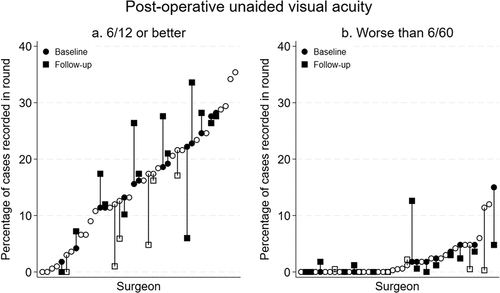Figures & data
Table 1. Baseline characteristics of surgeons who commenced Phase I of the Better Operative Outcomes Software Tool study (n = 41).
Table 2. Characteristics of Phase 1 (baseline and follow-up rounds) surgical cases performed by surgeons who commenced phase I of the better operative outcomes software tool study. (n = 41 surgeons).
Table 3. Unaided post-operative distance visual acuity in phase I of the better operative outcomes software tool study according to surgeon and patient characteristics (n = 41 surgeons, 4233 cases).
Figure 2. Proportion of cases in each Phase I round with (a) no vision impairment (unaided visual acuity 6/12 or better) and (b) severe vision impairment/blindness (unaided visual acuity worse than 6/60) at 1–3 days after surgery. Circles represent baseline round data from each surgeon who commenced Phase I of the study (n = 41). Squares represent the follow-up round for surgeons who entered follow-up round data (n = 20). Solid shapes represent surgeons who were included in the primary analysis (n = 14). Surgeons ordered separately in each plot according to percentage of cases for each vision impairment category in the baseline round.

Table 4. Proportion of Phase I cases with post-operative vision impairment in the Better Operative Outcomes Software Tool study.


